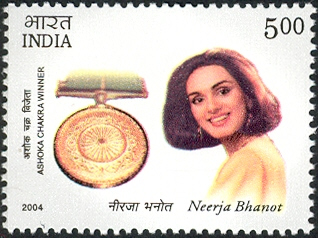
Neerja Bhanot was an Indian purser who died while saving passengers on Pan Am Flight 73 which had been hijacked by terrorists from a terrorist organization during a stopover in Karachi, Pakistan, on 5 September 1986, just two days before her 23rd birthday. Posthumously, she became the first female recipient and, until 2003, the youngest recipient of India's highest peacetime gallantry award, the Ashoka Chakra, as well as several other accolades from the governments of Pakistan and the United States. Her life and heroism inspired the 2016 biopic Neerja directed by Ram Madhvani and starring Indian actress Sonam Kapoor.

The Ashoka Chakra is India's highest peacetime military decoration awarded for valor, courageous action, or self-sacrifice away from the battlefield. It is the peacetime equivalent of the Param Vir Chakra (PVC) and is awarded for the "most conspicuous bravery or some daring or pre-eminent valour or self-sacrifice" other than in the face of the enemy. The decoration may be awarded either to military or civilian personnel.
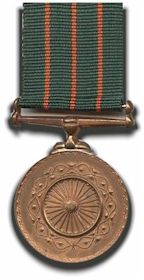
The Shaurya Chakra is an Indian military decoration awarded for valour, courageous action or self-sacrifice while not engaged in direct action with the enemy. It may be awarded to civilians as well as military personnel, sometimes posthumously. It is third in order of precedence of peacetime gallantry awards and comes after the Ashoka Chakra and the Kirti Chakra. It precedes the Yudh Seva Medal.[total recipients 2094]. [total awarded posthumously is 677].

The KirtiChakra is an Indian military decoration awarded for valour, courageous action or self-sacrifice away from the field of battle. It may be awarded to civilians as well as military personnel, including posthumous awards. It is the peacetime equivalent of the Maha Vir Chakra. It is second in order of precedence of peacetime gallantry awards, comes after Ashoka Chakra and before Shaurya Chakra. Before 1967, the award was known as the Ashoka Chakra, Class II.

The Rapid Action Force (RAF), a government controlled military unit and a specialised wing of the Central Reserve Police Force of India to deal with riot and crowd control situations.
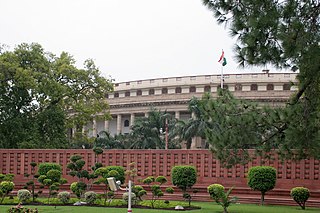
The 2001 Indian Parliament attack was a terrorist attack on the Parliament of India in New Delhi, India on 13 December 2001. The perpetrators belonged to Lashkar-e-Taiba (LeT) and Jaish-e-Mohammed (JeM) - two Pakistan-raised terrorist organisations. The attack led to the deaths of six Delhi Police personnel, two Parliament Security Service personnel, and a gardener – in total 9 – and led to increased tensions between India and Pakistan, resulting in the 2001–2002 India–Pakistan standoff. The five terrorists were killed outside the parliament.

Mohan Chand Sharma AC was an Indian police officer who was killed during the 2008 Batla House encounter in New Delhi. He was posthumously awarded the Gallantry medal Ashoka Chakra Award, India's highest peacetime military decoration, on 26 January 2009.
Kamlesh or Kamalesh is a given name which may refer to:
The Batla House encounter case was an armed Delhi Police operation to arrest terrorists of the Indian terror outfit Indian Mujahideen, hiding in a flat in the Batla House area of Jamia Nagar, Okhla, on 19 September 2008. The operation resulted in the deaths of two terrorists and one police officer, Inspector Mohan Chand Sharma, with the remaining terrorists arrested. On 15 March 2021, one of the arrested Ariz Khan alias Junaid, was sentenced to death for the murder of Inspector Sharma.

Colonel D. Sreeram Kumar AC is a serving Indian Army officer who was decorated in 2010 with the Ashoka Chakra, India's highest peacetime gallantry decoration.
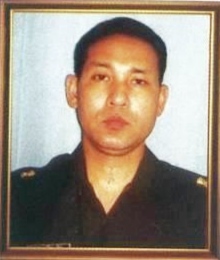
Major Laishram Jyotin Singh, AC was an Officer in the Army Medical Corps of the Indian Army, who died fighting a suicide bomber during the attack on the Indian Embassy in Kabul. Major Singh was awarded the Ashoka Chakra, the highest peacetime gallantry award in the Indian Armed Forces on 26 January, 2011.

Naib Subedar Chuni Lal AC, VrC, SM was an Indian Army soldier of 8th battalion. The Jammu and Kashmir Light Infantry. He was born in Bhaderwah, and basically from Gandhari Paddar and lived in Bhara village with parents Shanker Dass and Shakuntala Devi in Doda district of Jammu. Decorated with Vir Chakra and Sena Medal (Gallantry), JC-593527, Lal was killed in action on 24 June 2007 in a militant flush-out operation in Kashmir's Kupwara sector. These militants, all of whom were also shot dead, were trying to cross the Line of Control (LoC) and enter Indian territory. The success of this militant flush-out operation, which claimed his life, earned him the highest peacetime military decoration awarded for valor, courageous action or self-sacrifice away from the battlefield, the Ashok Chakra. He is the highest decorated soldier of Indian Army of all time, honored with Sena Medal, Vir Chakra and Ashok Chakra.

Major Dinesh Raghu Raman, AC was an Indian military officer with the 19th Battalion of the Jat Regiment who was posthumously awarded India's highest peacetime military decoration Ashoka Chakra.

Subedar Sujjan Singh Yadav, AC was an Indian Army Junior Commissioned Officer (JCO) with the 13th Battalion of the Kumaon Regiment. He was awarded the highest peace time gallantry award Ashoka Chakra posthumously for his action in Operation Rakshak in Kupwara, Jammu and Kashmir.

Naik Neeraj Kumar Singh, AC was a Non Commissioned Officer (NCO) in the Indian Army who was posthumously awarded the Ashok Chakra, the country’s highest peacetime military decoration on 26 January 2015. He had enlisted in the 13th battalion, Rajputana Rifles and was serving in the 57th battalion Rashtriya Rifles when he was killed in action.

Corporal Jyoti Prakash Nirala, AC was a member of the Garud Commando Force. He was posthumously awarded the Ashoka Chakra, India's highest peacetime military decoration in January 2018. He is the first airman to receive the award for ground combat and only the third one to receive it overall after Suhas Biswas and Rakesh Sharma.
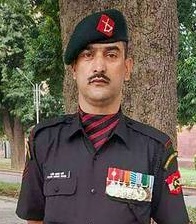
Lance Naik Nazir Ahmad Wani, AC, SM & Bar was an Indian soldier in the Jammu and Kashmir Light Infantry of the Indian Army. He was posthumously awarded the Ashoka Chakra, India's highest peacetime military decoration, in January 2019. He was the first recipient of the Ashok Chakra award from Kashmir region of the Indian state of Jammu and Kashmir.
Assistant Sub-inspector Babu Ram, AC (1972–2020) was a Police Officer of the Special Operations Group (SOG) Srinagar, who was awarded the highest peace time gallantry award, the Ashok Chakra.
Suresh Chand Yadav, AC was Junior commissioned officer of the Indian Army's Mahar Regiment who was killed in the line of duty during the Operation Vajra Shakti while on deputation to the 51 Special Action Group.He was posthumously awarded India' highest peacetime military decoration, Ashoka Chakra for his gallant action in the operation.














